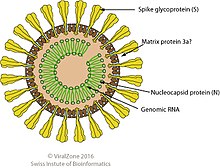Mesoniviridae
| Alphamesonivirus | |
|---|---|

| |
| Электронная микрофотография вирионов негативно окрашенных NAM DINH (NDIV) | |

| |
| Mesonivirus virion | |
| Virus classification | |
| (unranked): | Virus |
| Realm: | Riboviria |
| Kingdom: | Orthornavirae |
| Phylum: | Pisuviricota |
| Class: | Pisoniviricetes |
| Order: | Nidovirales |
| Suborder: | Mesnidovirineae |
| Family: | Mesoniviridae |
| Subfamily: | Hexponivirinae |
| Genus: | Alphamesonivirus |
Mesoniviridae -это семейство охваченных , положительных вирусов РНК в порядке нидовирале , которые заражают комаров . Семейство названо в честь размера геномов относительно других нидовирусов, с мезо- исходящими от греческого слова мезо , что означает среду, и - Ni является аббревиатурой Nido . [ 1 ] [ 2 ] [ 3 ]
История
[ редактировать ]Семья относительно новая, была обнаружена только в 2011 году. Первый вирус, который был назван вирусом Нам Дин , был обнаружен во вьетнамской провинции Нам ịnh . [ 2 ] Второй вирус, названный Cavally Virus , был затем обнаружен в Кот -д'Ивуаре . [ 4 ] Позже было обнаружено, что эти два вируса имеют один и тот же вид. Третий член этого первого вида, названный вирус Дак Нонг , был позже обнаружен в популяциях Culex Tritaeniorhynchus во Вьетнаме. [ 5 ] В 2013 году в популяциях комаров были обнаружены еще четыре мезонивируса, все в Кот -д'Ивуаре, [ 6 ] А в 2014 году в популяциях комаров в Австралии были обнаружены четыре мезонивирусы, [ 7 ] Индонезия и Таиланд. [ 3 ]
Virology
[edit]Structure
[edit]Members of this family are enveloped, spherical in shape and 60–80 nm in diameter with club-shaped surface spikes. There are eight major structural proteins, including a nucleocapsid protein (25 kDa in weight), four differentially glycosylated forms of the membrane protein (20, 19, 18 and 17 kDa) and the spike (S) protein (77 kDa), which is cleaved to produce two S protein subunits (23 and 57 kDa).[6][4]
Genome
[edit]
The genomes are linear, positive-sense, polycistronic, single-stranded RNA, and are about 20,000 nucleotides in length, with a 3' poly(A) tail and seven major open reading frames (ORFs). Two overlapping ORFs, together known as ORF1ab, are at the 5'-end, encoding the major non-structural proteins and are expressed as a fusion protein by ribosomal frameshift. ORFs 1a and 1b contain six replicase domains, as well as the 3'-5' exoribonuclease (ExoN) that controls RNA replication fidelity and a 2'-O-methyltransferase, both of which are found in larger nidoviruses. ORF 1b also encodes an N7-methyltransferase.[2][4]
Taxonomy
[edit]
Mesoniviridae is a member of the order Nidovirales, an order of +ssRNA viruses with animal hosts. The family has only one subfamily, Hexponivirinae, which contains only one genus, Alphamesonivirus. There are 8 subgenera and 10 species in Alphamesonivirus:[8]
The discovery and phylogenetic analysis of four additional mesoniviruses in 2013, named Hana virus, Méno virus, Nsé virus and Moumo virus, has suggested that they represent at least three new species of mesoniviruses.[6] Additionally, in 2014 four potentially new species were discovered in Australia, Indonesia, and Thailand, named Casuarina virus, Karang Sari virus, Bontag Baru virus, and Kamphaeng Phet virus, respectively.[3][7]
References
[edit]- ^ Lauber, C.; Ziebuhr, J.; Junglen, S.; Drosten, C.; Zirkel, F.; Nga, P. T.; Morita, K.; Snijder, E. J.; Gorbalenya, A. E. (2012). "Mesoniviridae: A proposed new family in the order Nidovirales formed by a single species of mosquito-borne viruses". Archives of Virology. 157 (8): 1623–1628. doi:10.1007/s00705-012-1295-x. PMC 3407358. PMID 22527862.
- ^ Jump up to: a b c Nga, P. T.; Parquet Mdel, M. D. C.; Lauber, C.; Parida, M.; Nabeshima, T.; Yu, F.; Thuy, N. T.; Inoue, S.; Ito, T.; Okamoto, K.; Ichinose, A.; Snijder, E. J.; Morita, K.; Gorbalenya, A. E. (2011). Baric, Ralph S (ed.). "Discovery of the First Insect Nidovirus, a Missing Evolutionary Link in the Emergence of the Largest RNA Virus Genomes". PLOS Pathogens. 7 (9): e1002215. doi:10.1371/journal.ppat.1002215. PMC 3169540. PMID 21931546.
- ^ Jump up to: a b c Vasilakis, N; Guzman, H; Firth, C; Forrester, N. L.; Widen, S. G.; Wood, T. G.; Rossi, S. L.; Ghedin, E; Popov, V; Blasdell, K. R.; Walker, P. J.; Tesh, R. B. (2014). "Mesoniviruses are mosquito-specific viruses with extensive geographic distribution and host range". Virology Journal. 11: 97. doi:10.1186/1743-422X-11-97. PMC 4038087. PMID 24884700.
- ^ Jump up to: a b c Zirkel, F.; Kurth, A.; Quan, P. -L.; Briese, T.; Ellerbrok, H.; Pauli, G.; Leendertz, F. H.; Lipkin, W. I.; Ziebuhr, J.; Drosten, C.; Junglen, S. (2011). "An Insect Nidovirus Emerging from a Primary Tropical Rainforest". mBio. 2 (3): e00077–e00011. doi:10.1128/mBio.00077-11. PMC 3111606. PMID 21673192.
- ^ Kuwata, R.; Satho, T.; Isawa, H.; Yen, N. T.; Phong, T. V.; Nga, P. T.; Kurashige, T.; Hiramatsu, Y.; Fukumitsu, Y.; Hoshino, K.; Sasaki, T.; Kobayashi, M.; Mizutani, T.; Sawabe, K. (2013). "Characterization of Dak Nong virus, an insect nidovirus isolated from Culex mosquitoes in Vietnam". Archives of Virology. 158 (11): 2273–2284. doi:10.1007/s00705-013-1741-4. PMC 7087109. PMID 23728735.
- ^ Jump up to: a b c Zirkel, F.; Roth, H.; Kurth, A.; Drosten, C.; Ziebuhr, J.; Junglen, S. (2013). "Identification and Characterization of Genetically Divergent Members of the Newly Established Family Mesoniviridae". Journal of Virology. 87 (11): 6346–6358. doi:10.1128/JVI.00416-13. PMC 3648093. PMID 23536661.
- ^ Jump up to: a b Warrilow, D; Watterson, D; Hall, R. A.; Davis, S. S.; Weir, R; Kurucz, N; Whelan, P; Allcock, R; Hall-Mendelin, S; O'Brien, C. A.; Hobson-Peters, J (2014). "A new species of mesonivirus from the Northern Territory, Australia". PLOS ONE. 9 (3): e91103. Bibcode:2014PLoSO...991103W. doi:10.1371/journal.pone.0091103. PMC 3966781. PMID 24670468.
- ^ «Международный комитет по таксономии вирусов (ICTV)» .
